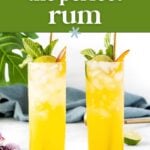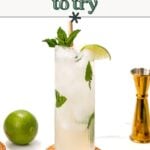Rum 101 is your complete guide to understanding this sugarcane-based spirit, whether you’re brand new to rum or just want to upgrade your bar cart. Learn the differences between white, gold and dark rums — and what those labels really mean. It’s an easy, no-nonsense guide that helps you buy and enjoy rum with confidence.

DISCLAIMER
*This post may contain affiliate links, meaning Feast + West may receive commissions for purchases made through those links — at no cost to you. All opinions are our own. Please read our full disclosure for more information.
Everything You Need to Know about Rum
Welcome to Rum 101! This sugarcane-based spirit from the Caribbean is definitely worth a second look at your home bar.
One of the first cocktails I ever tried (and loved) was the mojito and rum is also the basis for another favorite, the dark & stormy. But the fun doesn’t stop at summertime drinks — it’s delicious at the holidays in drinks like hot buttered rum. I think it’s fair to say that rum and I get along just fine!
Some people don’t love rum, but I think it deserves a second chance! These guides are designed to teach you about spirits, so you can know more about what you’re putting into your drinks and feel more confident choosing the right bottles. Plus there’s more than a few recipes to help you use up that bottle as you learn to love it!
What is rum?
Rum is distilled from the fermented juices of pure sugarcane, sugarcane syrup, sugarcane molasses and other sugarcane byproducts. Though distilling processes vary from country to country, most rum-producing countries mandate that it must be aged. (Brazilian cachaça is unaged, so it’s not really a form of rum.)
Most rum is produced in the Caribbean countries, where sugarcane is a big-money crop. It’s made primarily with sugarcane molasses, which is a byproduct of the creation of sugar.
Producers used to toss the molasses, but now they can make both sugar and rum with their crops. Sugarcane grows best in tropical climates because of the high heat and moisture. It can grow up to 19 feet tall and 1.5 inches in diameter, but its size makes it laborious to harvest.
To make rum, the cane is hand- or machine-harvested, then stripped of its leaves, and crushed or mashed to extract the juices. The juice is boiled several times to concentrate and crystallize the sugar.
The fermentation process generally takes place in large metal tanks or oak barrels, lasting from 24 hours to several weeks, depending on what type of rum is produced.

What rum tastes like
Rum has a warm, rich flavor that can range from light, sweet and buttery to crisp, spicy and earthy, depending on how it’s made and how long it is aged. At its core, rum often carries notes of caramel, vanilla and brown sugar, because it’s distilled from sugarcane or molasses.
Different types of rum have slightly different flavor profiles. Rums aged for longer, like gold rum and dark rum, have a woody, slightly smoky flavor thanks to the oak barrels they’re aged in. Spiced rum and coconut rum are flavored rums, made by infusing ingredients or adding artificial flavoring.
Types of rum
There are several types of rum you can find at the liquor store:
- White rum: Also called light rum or silver rum, this is the most common type of rum. It’s light and crisp and great for mixing. They go well with fruit flavors for daiquiris and mojitos.
- Gold rum: This medium-bodied rum is slightly stronger, aged in oak barrels. Also called oro or ambre, it’s great for fruity cocktails.
- Dark rum / black rum: Rich with a caramel flavor and deep color, it goes well in the Mai Tai or on its own, served neat or over ice.
- Rhum agricole: Very full-bodied, rhum agricole is made from sugarcane juice, not molasses. Like the molasses-based ones above, agricoles range in color from white to gold to dark. They also have floral and vegetal aromas and flavors.
- Flavored rum: Rum gets a new flavor with artificial flavorings like coconut, spices or pineapple. You can also make these yourself. Try my friend Katy’s lime and mint infused rum in your next mojito!

How to drink rum
Similar to other distilled spirits like whiskey, rum can be served with or without mixers. It is often enjoyed in mixed drinks like a rum & coke, but a good rum can also be enjoyed on its own.
You can sip it straight, of course, or try it in a spirit forward cocktail like a rum old-fashioned. Citrus and bitters can help to bring out certain flavors in the rum. If you wish to try sipping rum, you can really appreciate its sweet undertones, but it’s best enjoyed slowly. I do it like this:
- Pour a small amount into a glass, such as a rocks glass *. Let it sit for a moment to open up.
- Take a small sip, letting it coat your palate and breathe out through your nose to pick up the nuanced aromas.
- Only then should you start taking bigger sips! Now, enjoy.

The best rum brands
The best rum for you is going to depend on your taste preferences and what you plan to make with it. As with all my spirit guides, I always tell you to buy the best alcohol you can afford, and the same goes for Rum 101! But if you have a bit of cash to spare, a mid-shelf rum is the best bang for your buck.
Most rum distilleries produce and sell a variety of types of rum, including white rums and aged rums, plus a number of flavored options.
- Angostura
- Appleton Estate
- Bacardi
- Barbancourt
- Captain Morgan
- Cruzan
- Don Q
- El Dorado
- Gosling’s Black Seal
- Havana Club
- Mount Gay
- Plantation
- Ron Rico
My favorites
I find rum to be pretty affordable, and most often buy Cruzan or Bacardi for mixed drinks. I’ll splurge on a nicer aged rum like Appleton, El Dorado or Flor de Cana to sip or make stronger drinks.
For spiced rum or flavored rum, the cheaper brands will taste more fake, in my opinion. Kraken is my favorite of the cheaper spiced rums. Either infuse them yourself or grab a quality brand like Don Q or Mount Gay.
In general, if a bottle doesn’t list the country it was made in, I tend to steer clear. Quality rums are usually proud to highlight their origin. When companies source inexpensive bulk rum, they often label it simply as “Caribbean rum” without specifying a country.

Non-alcoholic rum
If you need a non-alcoholic version of rum for mocktails, there are many zero-proof rum options! You can even make your own homemade zero-proof rum with spices and fruits.
Use it to make non-alcoholic versions of rum drinks like a virgin mojito, a frozen virgin strawberry daiquiri or a dark & stormy mocktail. Here are a few of my favorites:
zero-proof rums
 Buy Now →
Buy Now →  Buy Now →
Buy Now →  Buy Now →
Buy Now → *
Rum recipes
We can’t finish Rum 101 without a few recipes! Here are some common ways you can use the bottle of gin on your bar cart *.
Tiki drinks: Rum is a staple in tiki drinks especially. Try it in the tropical and sweet mai tai, a pineapple painkiller or the mysterious and complicated jungle bird. Of course, if you like long walks in the rain, you’d also like a piña colada, which is also made with rum. Lots of tiki recipes call for two kinds of rum, which can deepen the complexity of the flavors (the zombie drink uses three — hence the name).
Classic rum cocktails: You already know the classic mojito, but rum is delicious with fruity versions like this strawberry mojito or lemon mojito. There’s also the classic daiquiri and its brother the Hemingway daiquiri, beloved in Cuba. The Airmail cocktail is a lesser-known Cuban drink with champagne that is one of my faves.

New Orleans drinks: Rum is a popular ingredient in New Orleans, an important locale in cocktail history. The hurricane cocktail and milk punch are two classics created there. You’ll also find many a frozen daiquiri and fish bowl drink in go-cups on Bourbon Street.
Well drinks: These are quick and easy recipes that will help you get to know rum. The Cuba Libre mixes rum with coke and lime juice. It’s also an ingredient in the infamous Long Island iced tea.
Holiday drinks: Rum has its place in the holiday season and makes for a delightful cup of cheer!
- It’s excellent in creamy drinks like eggnog and spiked hot chocolate.
- Rum is fantastic in a warm drink like a soothing rum hot toddy, classic wassail or cheery hot butterbeer.
- Fruity drinks and rum are a great match, like this Christmas twist on the mojito.
- The warmth of spiced rum is especially welcome this time of year — try it in this pear Thanksgiving punch or a white cranberry mule.

Rum holidays
Though you don’t need a holiday to enjoy rum, it’s always fun to make an occasion out of it. These annual occasions are a fun time to bring out the rum!
- National Hot Buttered Rum Day: Jan. 17
- National Piña Colada Day: July 10
- National Mojito Day: July 11
- World Rum Day: July 12
- National Daiquiri Day: July 19
- National Rum Day: Aug. 16
- National Rum Punch Day: Sept. 20

FAQ
Start with a bottle that’s smooth, versatile and under $30. I always recommend something like Plantation 3 Stars (light), Flor de Caña 4 Year (gold) or Diplomatico Mantuano (dark). These play well in cocktails but are also mellow enough to sip — no burn, no regret. If you need a budget option, Bacardi is a solid choice.
Yes, you can technically swap them in a pinch, but it changes the drink’s personality. Light rum keeps it crisp and clean (think a Daiquiri), while dark rum adds richness and spice (perfect for a Rum Punch). If a drink is built around the rum’s flavor, like a Mai Tai, stick to the type the recipe calls for.
Overproof means it’s stronger — often 50% ABV or more. A little goes a long way. We often use it in tiki drinks like Zombies for extra kick or float it on top of punches for dramatic flair. Just don’t pour with a heavy hand — it’s potent stuff!
Most rums are 40% ABV (alcohol by volume), similar to vodka or whiskey. Overproof rums can reach 50%–75% ABV or more, so check the label before mixing.




















Leave a Reply